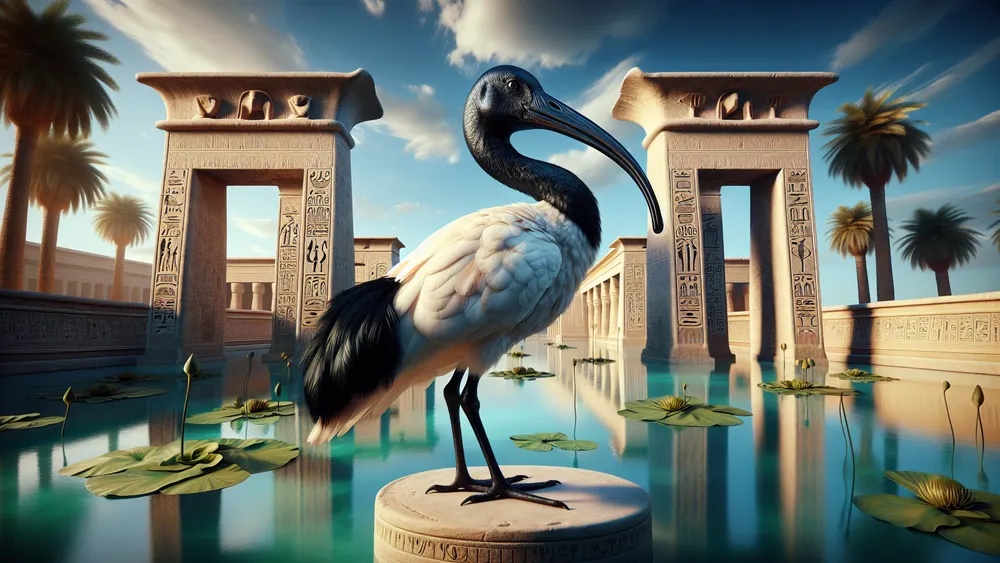Sacred Ibis: Ancient Egyptian Symbol Of Wisdom
Instead of thinking of yourself in ancient Egypt, a time known for rich stories and deep respect for nature. Among the creatures with meaningful roles, the Sacred Ibis is quite interesting. This bird, which has a long, curved beak and nice white feathers, wasn’t just often seen along the Nile; it was a respected sign of wisdom.
Key Points:
- The Sacred Ibis, Threskiornis aethiopicus, symbolized wisdom in ancient Egyptian culture.
- Linked with Thoth, the god of wisdom, it appeared in hieroglyphs and religious items.
- Found in wetlands and along rivers in sub-Saharan Africa and the Middle East.
- Eats insects, small fish, and other water animals using its long, curved beak.
- Not endangered, but faces threats like habitat loss and pollution.
- The Sacred Ibis remains a symbol of wisdom in modern art and media.
This post will look at the Sacred Ibis, checking its looks, role in old Egyptian religion, and its lasting impact in today’s world. We will see its link with Thoth, its usual living places and what it does naturally, showing the many meanings of this bird. So, if you like tales or just really want to know, the story of the Sacred Ibis is interesting and informative.
Sacred Ibis: Overview and Key Facts
| Key Point | Description |
|---|---|
| Scientific Classification | The Sacred Ibis, called by scientists Threskiornis aethiopicus, is part of the Threskiornithidae family. |
| Physical Characteristics | The Sacred Ibis is easy to spot with its white feathers, black head and neck, and long, curved beak that points down. It is about 65-75 cm long. |
| Species Variations | While the Sacred Ibis is the most well-known, there are other types of Ibis, like the Glossy Ibis (Plegadis falcinellus) and the Scarlet Ibis (Eudocimus ruber). They have special traits like different colors and preferences for different places to live. |
| Cultural Significance | In old Egypt times, the Sacred Ibis was linked with Thoth, who was the god of wisdom, writing, and knowledge. It showed up in hieroglyphs and religious items. |
| Habitat | The Sacred Ibis is found a lot in wetlands, swamps, and by rivers in sub-Saharan Africa and parts of the Middle East. |
| Diet | This bird mostly eats insects, small fish, and other water animals. It uses its long beak to look for food in shallow waters. |
| Conservation Status | Now, the Sacred Ibis isn’t considered endangered, but destroying its home and pollution are big problems for its numbers. |
| Modern-Day Relevance | The Sacred Ibis is still a symbol of wisdom and appears in modern art, books, and media. |
Getting to Know the Sacred Ibis
To really understand the importance of the Sacred Ibis, it’s key to see its special traits and how it was seen in old Egyptian culture. We should look deeper into what makes this bird special.
What’s the Sacred Ibis All About?
The Sacred Ibis, called by scientists Threskiornis aethiopicus, is an interesting bird, part of the Threskiornithidae family. It’s surprising to know this bird is easy to spot with its white feathers, black head and neck, and long, curved beak that is used much like a tool for looking for food in shallow waters. Standing about 65-75 cm tall, the Sacred Ibis is a notable figure in both nature and old stories. There are other kinds of Ibis, with each having special things:
- Glossy Ibis (Plegadis falcinellus): Known for its shiny dark feathers that gleam in sunlight.
- Scarlet Ibis (Eudocimus ruber): Famous for its bright red feathers, found in South America and the Caribbean.
- Australian White Ibis (Threskiornis molucca): Looks a lot like the Sacred Ibis but lives mainly in Australia.
Seeing these traits helps us realize why the Sacred Ibis was so respected in old Egyptian times and why it still catches our attention now.
The Sacred Ibis, with its distinctive features, symbolizes reverence in ancient cultures and remains a noteworthy bird in nature.
The Sacred Ibis in Ancient Egypt’s Past
In old Egyptian times, the Sacred Ibis had a place of big respect and was tightly linked with religious actions. This bird was a symbol of wisdom and knowledge, showing the intellectual activities that were very valued in Egypt then. The Sacred Ibis was often shown in different kinds of art and writings, which always reminded people of its important place.
Think about walking through an Egyptian temple, seeing the Sacred Ibis carved into the walls; it showed how important it was in both spiritual and everyday lives.
Because the bird is linked with Thoth, its importance was even bigger. Thoth, shown with an Ibis head, was the god of wisdom, writing, and knowledge, like a modern teacher or scholar. The Sacred Ibis was thought to be Thoth’s earthly form, believed to bring divine wisdom and insight. Many objects and writings show the Sacred Ibis, such as:
- Hieroglyphs: Sacred Ibises pop up in Egyptian hieroglyphs, meaning wisdom and knowledge.
- Statues: A lot of statues of Thoth have an Ibis head, showing the bird’s divine link.
- Temple Carvings: Sacred Ibises are carved into temple walls, reminding people of their spiritual importance.
These showings highlight how much ancient Egyptians respected and admired the Sacred Ibis, a bird that still captures our thoughts today.
Sacred Ibis Stories in Egyptian Mythology
In Egyptian stories, the Sacred Ibis is often shown signifying wisdom and a holy connection. A well-known legend tells of the Sacred Ibis guiding lost travelers through the desert, which shows its role as a guard and guide. As it links with Thoth, the god of wisdom, this strengthens the bird’s standing as a symbol of knowledge and intellect. Picture ancient Egyptians telling stories of the Sacred Ibis, much like today’s tales of wise owls. The meanings given to the Sacred Ibis include wisdom, protection, and guidance, making it a respected figure in Egyptian stories. To better understand its place in mythology, we compare the Sacred Ibis with other sacred animals in Egyptian culture:
| Sacred Animal | Associated Deity | Meaning | Distinctive Traits |
|---|---|---|---|
| Sacred Ibis | Thoth | Wisdom, Knowledge, Protection | White feathers, black head, long beak |
| Cat | Bastet | Home, Fertility, Protection | Graceful, agile, respected in homes |
| Falcon | Horus | Kingship, Sky, Protection | Sharp vision, powerful flight, royal symbol |
This comparison adds to the understanding of different roles and meanings of these sacred creatures, with each adding to the rich story of Egyptian mythology.

Where They Live and Wander
Now that we’ve looked at the importance of Sacred Ibis in myths and culture, let’s focus on the places they live and how they act. Knowing these birds’ homes and movements is very important for seeing their place in the ecosystem.
Home Sweet Home for the Sacred Ibis
The Sacred Ibis is mostly seen in swampy areas, marshy places, and along the edges of rivers. They love these places, with lots of shallow water making it perfect for looking for food. Imagine these swampy areas are like crowded cities full of life for birds. Found mainly in sub-Saharan Africa, the Sacred Ibis is common in Egypt, Sudan, and South Africa. They do well in warm weather and like spots where water is easy to find, so they can walk through water and look for food. In addition, the nature they prefer has shallow waters full of water animals and plants, and warm weather that helps with making nests and breeding. Here are places where the Sacred Ibis is seen a lot:
- Egypt: Alongside the Nile River and its delta.
- Sudan: In the marshy places.
- South Africa: In many swampy areas and by the edges of rivers.
Knowing about these places they live helps us see the natural world of the Sacred Ibis and what they need to do well.
How Sacred Ibises Move and Behave
Sacred Ibises have ways they move around, which are interesting and caused by the need to find good places to find food and have baby birds. These birds move every season, going from one area to another to look for lots of food and good weather. Think of the Sacred Ibis starting a trip every season, traveling long distances to make sure they survive.
During not rainy times, they often move to wetter areas where there is lots of food, and when the wet time comes, they go back to their baby bird places. This way of moving around makes sure they can support themselves and their baby birds throughout the year. How they act with others and group actions are very important for the Sacred Ibis.
These birds are very social and often seen in large groups, just like a tight group where working together and talking are key. They use many sounds and body movements to talk to each other, keeping a complex group structure. When making nests and having baby birds, Sacred Ibises like to build their nests in groups, often in trees or in plant beds near water.
Their baby bird time happens at the same time as the wet season, providing enough food for the growing chicks. Both parents help in caring for the young, making sure they have food and are safe until they leave the nest. This way of working together to raise chicks shows the strong bonds and teamwork in Sacred Ibis groups.
Sacred Ibises move around in search of food and suitable conditions for their baby birds, traveling long distances each season to survive and support their offspring, relying on group actions and communication to maintain strong bonds and teamwork within their social structure.
What They Eat
Now that we’ve looked at how they move and how they act with others, let’s talk about what they eat. Knowing what these birds eat is important for getting their place in nature.
What’s on the Sacred Ibis Menu?
Sacred Ibis eats different kinds of food which include many small water animals. Their main foods are:
- Insects: Like beetles and grasshoppers.
- Small Fish: Found in shallow waters.
- Shellfish: Such as crabs and shrimp.
- Soft Animals: Which include snails and clams.
The Sacred Ibis uses its long, bent bill like a special tool to dig into the mud and shallow water, and look for hidden things. This way of looking for food lets them find many types of food, making sure they get the needed things to stay healthy and live long.
Having many kinds of food is important for the Sacred Ibis, as it gives them the needed vitamins and minerals for being healthy, supports their strong body defenses, and their long life.

Their Role in Nature
The Sacred Ibis is very important in its home areas, being both a hunter and part of nutrient moving. Eating insects, small fish, and other water animals helps control their numbers, keeping things in balance. When they look for food, they also help mix air into soil and water, making places better for other living things, which helps many other species.
Their presence helps many species that live in the same places. Yet they also fight with other birds for food. This fight can change how bird groups work. They have both fighting and working together with other species, sometimes eating with other birds without fighting directly.
These complex ways they interact show the Sacred Ibis’s important part in keeping health and a steady state of their ecosystems.
How They’re Doing and What Threats They Face
After looking at the Sacred Ibis’s place in the world, we should know how they are doing now, and the problems they deal with in the wild. Now, let’s get into the things that change their numbers and the work to save them.
How Sacred Ibises Are Doing Today
How they are doing now shows that the Sacred Ibis is mostly steady, but many big problems could affect their numbers. The IUCN Red List says the Sacred Ibis is not thought to be in danger right now, but local problems are still risky. Big problems are:
- Habitat Loss: Because of building cities and more farming.
- Pollution: Dirty stuff in water bodies changing what they eat.
- Climate Change: Changing their homes and travel routes.
Think about the problems these birds deal with as their homes get smaller and their food gets dirty. Work being done to save the Sacred Ibis includes help from governments and groups. These activities are fixing their home areas, stopping dirty stuff, and telling people. Everyone working together aims to make sure the Sacred Ibis stay well in their natural places.
Human Impact and Conservation Work
What people do has really changed the Sacred Ibis, with building cities causing loss of their home, dirty stuff messing with their food, and changing weather changing their places. Their once clean habitats are being taken over by more cities and farms. Different saving actions to fight these problems have been set up.
Home area fixing work, stop dirty stuff steps, and helping them have more babies are part of these actions. It’s like everyone working together to fix and clean a local park so it stays safe for all things living there. Local people do important things, like joining learning actions and people-led actions, to spread knowledge and encourage good actions.

By working together, these efforts make sure the Sacred Ibis stay healthy in their natural places.
Cultural and Modern-Day Significance
After looking at the work to save them and how people affect the Sacred Ibis, now, we check their importance in culture and today.
Sacred Ibis in Today’s World
The Sacred Ibis continues to grab the interest of people today, showing up in art, books, and media. Contemporary artworks display it, often as a sign of smartness and learning, just as in old Egypt. In books, the Sacred Ibis is a sign of being clever and knowing stuff, which comes from its link from history with the god Thoth.
Examples are in various books and films about old Egypt and its lasting influence. The sign of the Sacred Ibis in today’s culture stays important, reminding us of the never-ending search for knowing and understanding.
Sacred Ibis as a Symbol of Knowledge
The Sacred Ibis is seen as a symbol of knowledge mainly because of its link to Thoth, an old Egyptian god of writing and learning. He was often shown with the head of an Ibis, showing the bird’s link to thinking and learning things. The Sacred Ibis has features like careful eating habits and a job in stopping bugs that add to this meaning.

It is like how the owl in Western culture is similar, both showing knowledge. In different places, the Sacred Ibis is used as a symbol of knowledge; for instance, in school symbols and books that talk about ideas of smart thinking. This lasting sign keeps reminding us of the never-ending search for knowledge.
FAQs
1. What’s the lifespan of a Sacred Ibis?
The lifespan of a Sacred Ibis typically ranges from 15 to 20 years in the wild.
2. Are Sacred Ibises at risk?
Sacred Ibises are at risk due to habitat loss, pollution, and hunting pressures.
3. How did the Sacred Ibis get linked to Thoth?
The Sacred Ibis got linked to Thoth because the bird’s behavior and appearance were believed to embody the wisdom and knowledge associated with the god.
4. Can you find Sacred Ibises outside Africa?
You can find Sacred Ibises outside Africa, particularly in regions where they have been introduced, such as parts of Europe and the Middle East.







